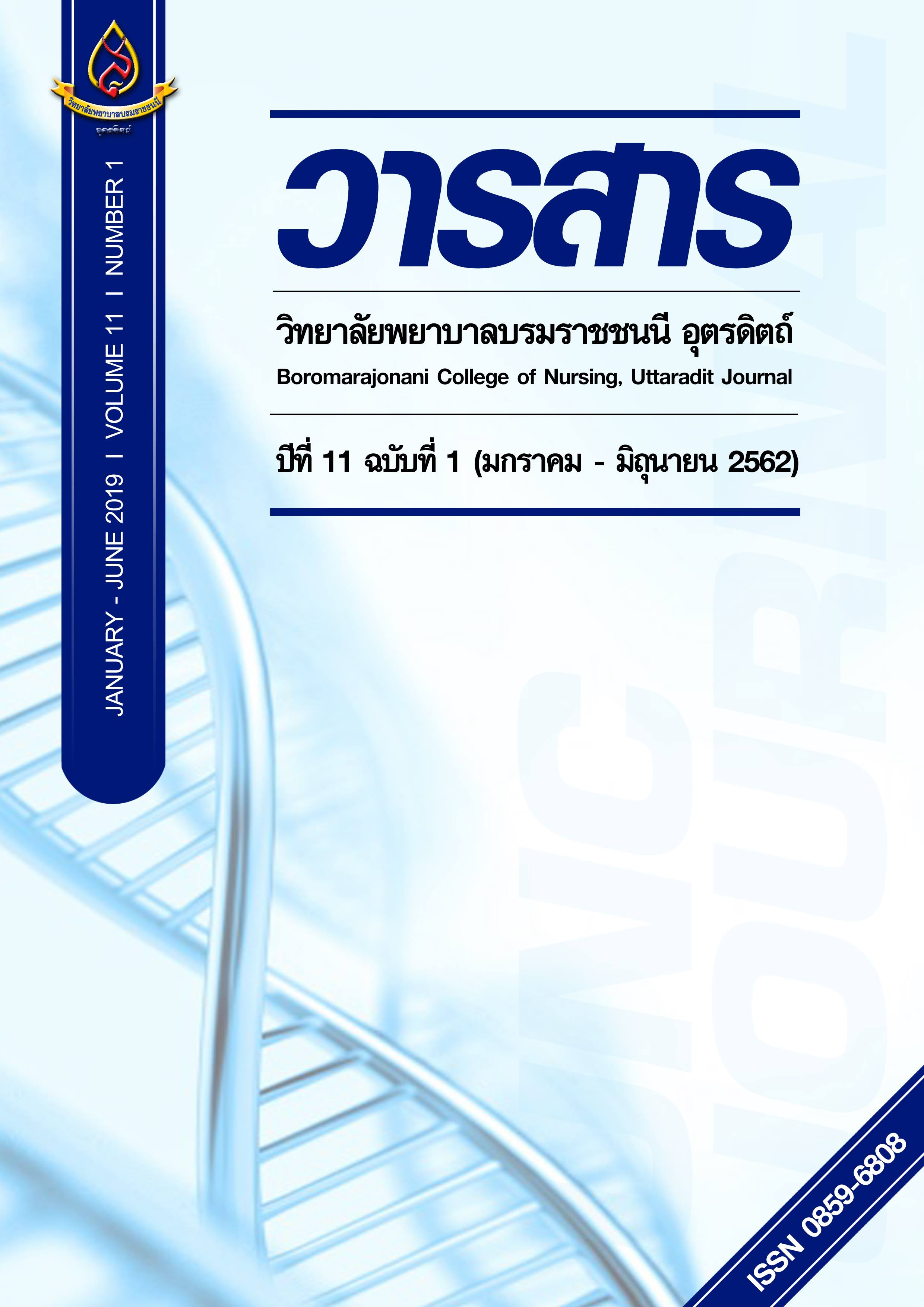ประสิทธิผลของโปรแกรมพัฒนาความรอบรู้ด้านสุขภาพในผู้ป่วยโรคความดันโลหิตสูงที่ควบคุมความดันโลหิตไม่ได้
Main Article Content
บทคัดย่อ
การวิจัยกึ่งทดลองแบบสองกลุ่มวัดผลก่อนและหลังการทดลอง มีวัตถุประสงค์เพื่อศึกษาผลของโปรแกรมพัฒนาความรอบรู้ด้านสุขภาพต่อความรอบรู้ด้านสุขภาพ พฤติกรรมการดูแลตนเอง และความดันเลือดแดงเฉลี่ยในผู้ป่วยโรคความดันโลหิตสูงที่ควบคุมความดันโลหิตไม่ได้ กลุ่มตัวอย่างเป็นผู้ป่วยโรคความดันโลหิตสูงที่ควบคุมความดันโลหิตไม่ได้ที่ได้รับการรักษาในโรงพยาบาลฟากท่า จังหวัดอุตรดิตถ์ มีระดับความดันโลหิตซิสโตลิกตั้งแต่ 140-179 มิลลิเมตรปรอท หรือระดับความดันโลหิตไดแอสโตลิกตั้งแต่ 90-109 มิลลิเมตรปรอท จำนวนกลุ่มละ 30 คน เครื่องมือวิจัย ประกอบด้วย 1) โปรแกรมพัฒนาความรอบรู้ด้านสุขภาพ ซึ่งพัฒนาขึ้นตามแบบจำลองกระบวนการความรู้ของความรอบรู้ด้านสุขภาพ มีระยะเวลา 10 สัปดาห์ 2) คู่มือความรอบรู้ด้านสุขภาพกับการควบคุมความดันโลหิตสูง และ 3) แบบสอบถามความรอบรู้ด้านสุขภาพและพฤติกรรมการดูแลตนเอง แบบสอบถามความรอบรู้ด้านสุขภาพและพฤติกรรมการดูแลตนเอง มีค่าความเที่ยงโดยใช้สูตร KR-20 เท่ากับ .94 และค่าสัมประสิทธิ์อัลฟาของครอนบาค เท่ากับ .80 ตามลำดับ วิเคราะห์ข้อมูลโดยใช้สถิติ เชิงพรรณนาและสถิติที
ผลการวิจัย พบว่าหลังการเข้าร่วมโปรแกรม คะแนนเฉลี่ยความรอบรู้ด้านสุขภาพและพฤติกรรมการดูแลตนเองของผู้ป่วยโรคความดันโลหิตสูงในกลุ่มทดลองมีค่ามากกว่าก่อนเข้าร่วมโปรแกรมและมากกว่า กลุ่มเปรียบเทียบอย่างมีนัยสำคัญทางสถิติที่ระดับ .05 (p<.05) และความดันเลือดแดงเฉลี่ยมีค่าน้อยกว่า ก่อนเข้าร่วมโปรแกรมและน้อยกว่ากลุ่มเปรียบเทียบอย่างมีนัยสำคัญทางสถิติที่ระดับ .05 (p<.05)
Article Details
บทความหรือข้อคิดเห็นใดใดที่ปรากฏในวารสารวิจัยการพยาบาลและวิทยาศาสตร์สุขภาพ เป็นวรรณกรรมของผู้เขียน ซึ่งบรรณาธิการหรือสมาคมศิษย์เก่า ไม่จำเป็นต้องเห็นด้วย และบทความที่ได้รับการตีพิมพ์เผยแพร่ถือเป็นลิขสิทธิ์ของวารสารวิจัยการพยาบาลและวิทยาศาสตร์สุขภาพ
References
2 Bloom, B. S. (1971). Hand book on formative and summative evaluation of student learning. New York: Graw-Hill Book Company.
3 Bureau of non communicable disease, Ministry of Public Health. (2017). Annual report 2017. Bangkok: Graphic & Design. (in Thai)
4 Chin, J., Morrow, D. G., Stine-Morrow, E. A., Connner-Garcia, T., Graumlich, J. F., & Murray, M. D. (2011). The process-knowledge model of health literacy: evidence from a componential analysis of two commonly used measures. Journal of health Communication, 16, 222-241. doi: 10.1080/10810730.2011.604702
5 Ekstrom, R. B., French, J. W., Harmon, H. H., & Dermen, D. (1976). Manual for the kit of factor-referenced cognitive tests. Princeton, NJ: Educational Testing Service.
6 Faul, F., Erdfelder, E., Lang, A. G., & Buchner, A. (2007). G*Power 3: A flexible statistical power analysis program for the social, behavioral, and biomedical sciences. Behavior Research Methods, 39(2), 175-191.
7 Halladay, J. R., Donahue, K. E., Cene, C. W., Quefeng, L., Cummings, D. M., Hinderliter, A. L.,…Darren, D. (2017). The association of health literacy and blood pressure reduction in a cohort of patients with hypertension: The heart healthy lenoir trial. Patient Education and Counseling, 100(3), 542-549. Retrieved fromhttps://dx.doi.org/10.1016/j.pec.2016.10.015
8 Health data center Ministry of Public Health. (2017). Report group criteria for noncommunicable disease. Retrieved fromhttps://hdcservice.moph.go.th/hdc/main/index_pk.php (in Thai)
9 Health systems development group, Bureau of non communicable disease. (2018). World campaign on high blood pressure day 2018. Retrieved from https://www.thaincd.com/document/file/info/non-communicable-disease/ (in Thai)
10 Ko, Y., Balasubramanian, T. D., Wong, L., Tan, W. L., Lee, E., Tang, W. E., … Toh, M. P. (2013). Health literacy and its association with disease knowledge and control in Patients with hypertension in Singapore. International Journal of Cardiology, 168, 116-117. Retrieved from https://dx.doi.org/10.1016/j.ijcard.2013.08.041
11 Levinthal, Morrow, Tu, Wu, & Murray. (2008). Cognition and health literacy in patients with hypertension. Journal of General Internal Medicine, 23, 1172–1176. doi: 10.1007/s11606-008-0612-2
12 Non communicable disease clinic of Faktha hospital. (2017). Patient with hypertension care report of Faktha hospital. N.P. (in Thai)
13 Office of the national economic and social development board, Ministry of Public Health, & Mahidol University. (2010). Strategic health plan 2011-2020. Retrieved from https://wops.moph.go.th/ops/oic/data/20110316100703_1_.pdf (in Thai)
14 Shi, D., Li, J., Wang, Y., Wang, S., Liu, K., Shi, R., … Chen, K. (2017). Association between health literacy and hypertension management in a Chinese community: aretrospective cohort study. Internal and Emergency Medicine, 12, 765-776. doi: 10.1007/s11739-017-1651-7
15 Thai hypertension society. (2016). Guidelines for treatment of hypertension in medicine. General Update 2012. Bangkok: Thai hypertension society. (in Thai)
16 Tnanachikhan, N. (2012). Preliminary statistics for research. Bangkok: Wittayapat. (in Thai)
17 Wang, Lang, Xuan, Li & Zhang. (2017). The effect of health literacy and self-management efficacy on the health-related quality of life of hypertensive patients in a western rural area of China: a cross-sectional study. International Journal for Equity in Health, 16, 1-11. doi: 10.1186/s12939-017-0551-9
18 World Health Organization. (2004). Reducing risk, promoting health life. Geneva, Switzerland: World Health Organization Retrieved from https://www.who.int//whr/2004/.(2009).

